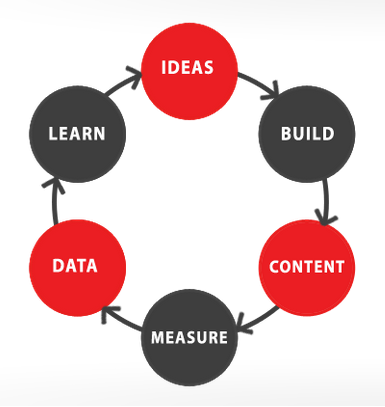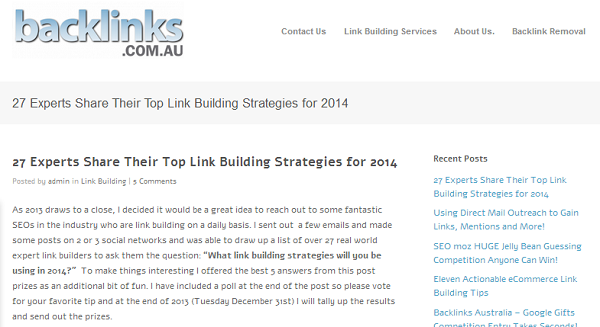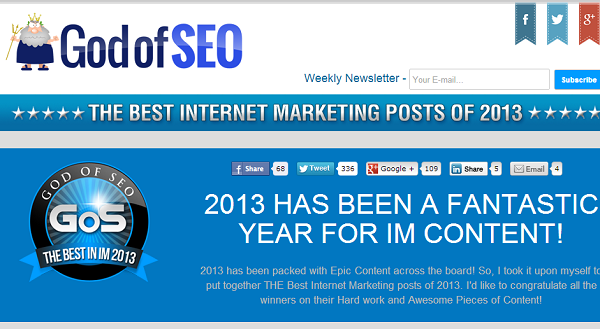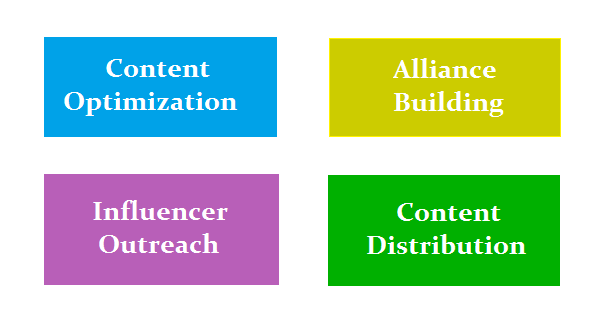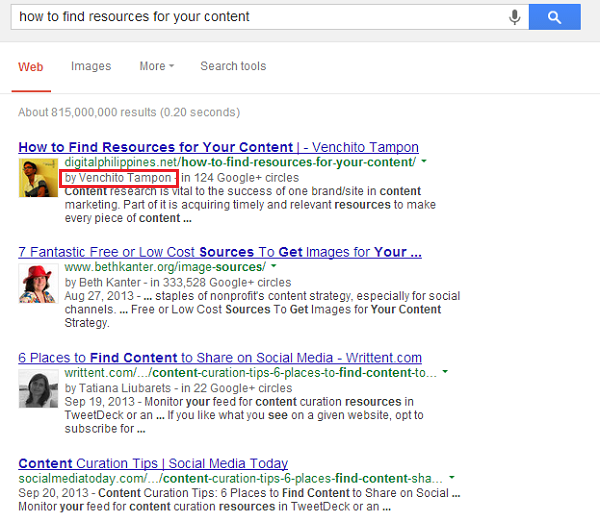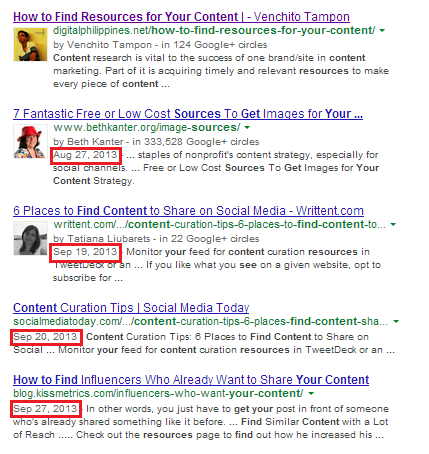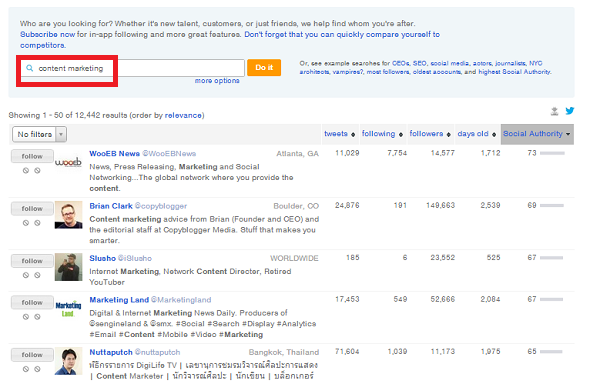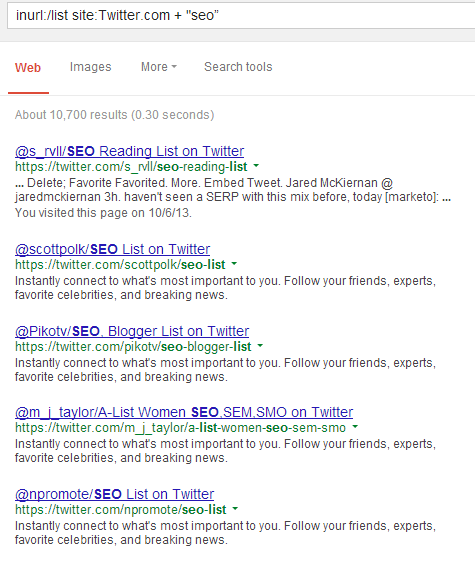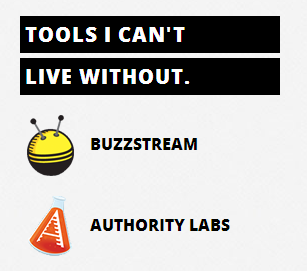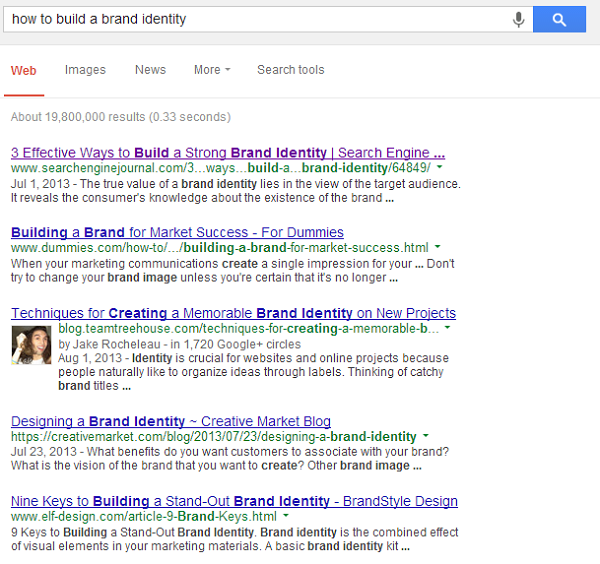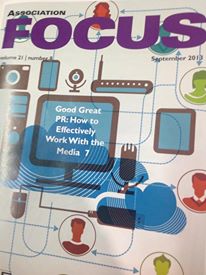How to Scale Your Link Building Campaigns for 2014 and Beyond
Scalable link building is a combination of a volume-oriented and efficient link building methodologies and strategies. The more links are being acquired through content and community-based link building tactics, the higher should be the efficiency developed in the overall campaign including the process, tools and the people working on it.
The primary idea in this approach is to focus both on the inner development and bulkiness of the activity since having more time performing a specific link building task, the higher is your chance of mastering it through constant improvement that adapts to what search engines are going after for this year and beyond.
The future of search will always emphasize the value of the business which comprises the nature of the operations, profitability and future economic benefits that should flow from different web places where customers are visible. With business’ value in mind, scaling link building efforts would result into more ROI-based results that drive authority, brand and social signals to the inner pages of the site where external sources are linking to.
Scalability in an ROI-focused link building campaign is essential for the following reasons:
- Increase in the present resources of the company (i.e. team members) can accommodate numerous demands of customers that would result into brand-related benefits (besides sales) such as positive feedbacks, brand awareness, effortless content promotion through word of mouth marketing, voluntary-given links and other secondary benefits (benefits that are not basically targeted by the campaign).
- Increase in workforce provides more time for the upper management to strategically plan the future development of the campaign (which will be more effective if priorities for different tasks are set beforehand).
- It fuels the growth of the business given that each of the team members are able to cope up with the changes/development that occur during the execution of the campaign which allows them to participate more in the strategic planning and hands-on activities.
- It standardizes the brand’s methodologies and processes for new team members. The higher the need for scalability, the more efforts should be exerted for the basic necessities of the link building team (i.e. basic manual for newbies). This will reduce the time and budget that will be needed for personal training for each team member given that manual or one general resource could help newbies to learn about every detail of the link building process (i.e. link building outreach) and go back to the section they haven’t learned and which needs repetitive learning.
For any reason, growth in link building requires scalability. The more resources (workforce, tools, etc..) are scaled for the campaign, the likelihood of continuous improvement is higher (through constructive criticisms and regular feedbacks from team members/leaders).
Without setting your team to focus on scaling certain elements in link building, growth is unlikely possible for the campaign.
The question is, in what areas should scalability be focused on?
Three Main Focus of Scalable Link Building
1. People
For obvious reasons, link building will always need people to run a campaign. With a mindset of allowing your team members to reach their maximum potentials, it would be easy for you to scale each of them (since proper training leads to scalability). Scalability in people sense is flexibility. If your people are able to work on multiple tasks, then you are effective in scaling your team.
Essentially, focusing on how you could improve the skills of your team members would greatly impact the whole campaign’s results. The more skillful your team is, the better your results will be.
Here a few tips to scale your team members:
- Think of a good list of questions that you want to ask for your applicants in the recruitment process of your team. You may either add examinations to get a feel of how knowledgeable they are in link building or offer a two-week paid test trial to see the output they can finished within that short period of time.
- Create a database that is filled with the basic resources/information that your team members must learn about as part of the team. I would suggest that you provide two tutorials:
- Video training tutorials for hands-on activities (for applications) with transcript or outline below each video.
- Text-based content (for theories)
Make it easy for your people to read each section by adding quick links at the top of the page/post.
- Let your team members send a weekly report about the results of their work, challenges they faced during the week and improvements that they can do for the team. You can add a section to your task management platform for questions and feedbacks.
Further Reading:
2. Tools
Without tools, it would be quite difficult for your team members to scale each task that you assigned to them. Tools will always play a big role in reducing the time spent for a particular activity, and ensuring that the results for every work are high quality and accustomed to the expectations set by the team.
A few tips to scale your link building tools are stated below:
- Use spreadsheet and Excel functions to speed up the process of one subset activity (i.e. finding duplicates in the list).
- Create your own tool for your in-house works to setup only one platform for all the multiple tasks you’re handling for each campaign.
- Select only a few tools that your service requires you to scale. Compare two or three tools and see which one could make your work faster and easier. Do this every 6 months or 1 year (add new tools that are publicly offered by other SEO agencies for comparison). Remember not to spend almost half of your budget for paid tools since you can also scale activities with selected free SEO tools.
- Ensure the privacy of access to each of your tools (restrict ex-members from any methods to login in any of your regular tools).
- If you’ve built a strong readership and personal branding, try contributing to product websites that offer regular content contribution on their blog sections. I’ve seen many of them offer paid subscriptions to their products in exchange for regular write-ups (monthly/weekly). By doing this, the cost assigned for tools would reduce dramatically given that you’re almost free of charge to some paid products.
3. Process
Scalable link building will not be completely performed without a process. Systems or processes will only work well if they are continuously being tested by adding some changes to them to see some improvements in the results.
Process is hard to scale since it requires testing/updates before seeing big results. Conducting multiple testings would need much higher budget and more time for the team to quickly adjust to any immediate changes that will happen during the testing period.
However, there are a few ways to make it much easier for the team members to grasp each detail of the process without making them overwhelmed with the big picture of it.
- Conduct an initial meeting with your team members for you to explain to them each activity that your team needs to perform to satisfy your clients’ needs.
- Illustrate your link building process by adding visuals/diagrams that describe how the system works.
- List down the time needed for each task to be completed. Make sure that you consider the completion time for each task when you assigned all the tasks to your team members (i.e. 15 hours to find 180-200 qualified link prospects). This will help you identify who are performing at the above par or below par output and which of them are qualified for regularization.
- Take note of frequently asked questions from your team members. Analyze which part of the link building process is difficult to understand and create a detailed video explaining that particular task.
- Perform a monthly evaluation of the team’s output by simply listing down tasks that are quickly completed by the team and activities that need more members to work on.
- Involve your team members for monthly feedbacks and consider their suggestions/feedbacks for future updates to your link building process.
- Compute your client acquisition/retention output such as:
- Retention rate (how many clients are still getting your service?)
- Client acquisition rate (how many client inquiries do you receive in a monthly basis?)
- Top assisted conversions (which websites bring you the most number of potential clients?)
There are a lot more tips that I will share on my future posts about client acquisition, task management and other process-based activities. But for now, the above tips are the most vital applications of the overall link building process.
People, tools and process are the fundamental things you have to focus on scaling your link building campaigns since these three core elements would greatly impact your business’ growth and branding.
What to Scale in Link building for 2014 and Beyond?
Content Assets
Understanding how to extract the most value out of the existing and future content assets is a must to consider for next year’s content marketing. Creating high quality content assets is not enough. You have to determine the future economic benefits of your content and how you can amplify the reach of each of your content piece.
Here are a few tips to scale your content:
- Focus on content optimization. Ensure that your asset has the essential characteristics of a high quality content:
- Comprehensiveness. The ability of the content to be mostly cited by media outlets and industry-related publications because it provides data/information that is credible and useful to different groups of audience.
- Shareable. Social sharing buttons are visible both on the above and below the fold of the page (or is static in one area). In addition, the content should be capable of multiplying its shares by having influencers mentioned in the post (either their insights are included or their content are being referenced for additional resources).
- Design. First impression lasts in content marketing. In most cases, people shared the content once they are attracted with how text/images/videos are formatted within and on the page.
- Use your content to leverage business relationships. Connect with influencers who’ve shared/linked to your content. Mentioned their content on your posts (especially posts that linked to your content) to put yourself to their radars and circles.
- Instead of doing one-time guest post, pitch authoritative blogs/news sites for regular content distribution. This would help you increase your branding, authority and your content’s ability to reach a wider group of audience (especially if you linked your best posts from your content distribution posts – i.e. guest posts).
- Invest in content development. Update existing content assets to adapt to its target industry’s environment.
- Repurpose your content to different content formats (i.e. slide presentation, ebook, etc..) to increase its likelihood of being seen by top industry curators who might linked to your other content formats.
- List down all existing linkable content assets in a spreadsheet (content inventory). Identify which of them had received a significant amount of links (by looking at the page’s number of referring domains) and shares (use Topsy). Schedule one week for linker outreach to promote existing content assets that have potential for active and passive link acquisition.
Link Acquisition
Link acquisition is a tedious activity that demands proper execution and analysis to dramatically increase the number of links acquired, penetrate influencers’ radars and build relationships with the target audience and comprehend the behavior of customers in the industry.
Scaling link acquisition would basically dig into one activity: careful qualification of link prospects. Here are two types of link qualifiers that would extract only high quality link prospects from the list.
- Automated link qualifiers such as:
- Ad placements
- Pagerank of URL
- Pagerank of domain
- Domain Authority of the site
- Page Authority
- Keywords placed on the most important areas of the page
Manual link prospecting using the above link qualifiers could possibly create a list of 50+ link prospects in an hour with the help of tools like bulk PR checker, Mozbar, Scrape Similar and a little common sense to identify the site’s ads marketing (whether or not the website is designed to provide value to the community or just earn passive income).
- Manual link qualifiers such as:
- Relevancy of the target page/site to the produced content or the client’s website itself.
- Obtainability or link acquisition level based on the relationship status of the link prospector/client to the link target.
- Competitor identification. Determining whether or not the link target is a competitor.
- Content/page has a good context in terms of grammar and spelling.
- Is the link placed on the link target’s page automated or human-generated?
- Quality of blog comments
- Accessibility of the webmaster (is the site owner’s email or contact form visible on the page?)
With these two types of link qualifiers, you can now scale the link prospecting efforts of your team by allowing them to focus on the important factors that make links good quality.
Other scalable link prospecting tips:
- Provide regular feedbacks to link prospectors (explain why link prospects are approved and others are not).
- Use tools for massive link prospecting like Ontolo and Scrape Similar and store the results in a link prospecting sheet.
- Categorize unapproved link prospects based on their link opportunities. Execute other link building efforts using those unapproved list of prospects (i.e. posting articles to industry-related forums). Approval of link prospects is based on the type of link building that the team is working on: “Approved” for resource/links page; “Not Approved” for forum links.
Outreach
Outreach efforts are scaled through evaluating these activities and results:
- Email templates that work best in getting higher response and link acquisition rates.
- Feedbacks received from link targets and their behavior towards your outreach.
- Setting an expected response rate and/or link acquisition rate for every outreach efforts (based on the industry’s environment and response to link building outreach). This would help you determine if your effort is at sub-par or above the average standard.
Here are a few initiatives that can improve the scalability of your outreach:
- Use interns for small outreach tasks like uploading CSV files (spreadsheet of contact names and emails) to outreach management tools like Buzzstream.
- If you’re only using Gmail and other free email marketing solutions, you would want to let your interns work on editing the email message (replacing the [Name of Site Owner] and [URL] with the actual contact names and websites of the link targets). This way, you would just have to check all the drafts and make it more personalized by adding introductory paragraphs to the template.
- Contact webmasters who had linked to your competitor’s content. Try a second blow of emails that is more personalized than the outreach template you’ve used on your initial contact.
Branding
The future of link building will always be on the branding and other marketing objectives of online businesses. Targeting conversions, increasing brand awareness and establishing influence and authority are a few marketing-centric goals that can send brand and social signals to the pursued website/content.
The following initiatives are best to scale your site’s branding activity:
- Take advantage of the top curators in your industry by starting to build a rapport with them and get updates for their planned interviews/round-ups. Provide your best insight/tip/strategy/tactic to the curator to get high quality backlinks over time given that the post is more likely to attract more link love from top media outlets in the industry (especially if the crowdsourced content was able to rank for a target keyword).
- Consistently create persona-based content to win top awards in your industry. This could amplify the reach of your awarded content and increase the likelihood of getting direct traffic visits.
- Participate in industry-related communities like blogs and forums by providing high-valued answers to the most commonly-asked questions.
- Start engaging with people who mentioned your brand/product/service on various web places. Regular brand mention monitoring could give you links when you asked those potential linkers politely via email or social tools.
Scalable link building is both improving the efficiency and effectiveness of your link building campaigns and understanding how to improve the value of your link building results.
To end this post, I want to thank James Norquay for giving me an awesome gift (15 GB USB with a bottle opener on its other side).
If you liked this post, kindly share it to your circles/networks and follow me on twitter @venchito14.
Merry Christmas to all of you guys!
Infantry Square to Promote Your Content
Promoting your content is like bringing your military troops in front of your enemies. It’s either you lose or win the battle. Whatever the result will be, you have to prepare yourself before entering into the war of content marketing.
Part of the preparations is creating your own solid following base. This comprises your own troops and your allies. Designing your content strategy in this approach would help you build a competitive advantage over your enemies because some of them focus only on building low quality links (blog networks, low-quality guest posting, buying links, etc..) which would only bring down their chances of winning the battle (especially now that Google is targeting sites that are engaging in aggressive webspam tactics).
Content that is designed to satisfy user’s intent is what matters most in today’s online marketing. However, creating a content piece does not guarantee your victory. You have to get in front of your target audience with the content that you have and entice them to take necessary actions for your brand (signing up for your newsletter, follow you on social networks, buy your product/service or whatever conversion goals you’ve setup beforehand). This makes content promotion evenmore complicated given that there are lots of effective promotional tactics that your competitors might be using for their own content strategy.
How to Promote Your Content Using the Four Core Principles
In this post, I cover the four principles of a robust content promotion that will differentiate you from others and will certainly enhance your brand experience towards your target audience (customers and influencers).
1. Content Optimization
Content that is not optimized both for search engines and end users would leave you behind the battle. The reason is that people would not be able to find your content unless certain web elements are present on it. Some of them are:
Page title
Using your target keywords in your page title would help your content improve its performance on search rankings. However, you should not optimize it for the sake of keyword density. Rather, ensure that your content matches to the keyword you’re targeting for by satisfying your user’s intent on clicking that page.
Applying actionable page title is also one of the best implementations you can do for your content because this can entice searchers to click through your content as they see it on search results (people are now looking for “how to” content pieces rather than the “what and why” of a topic).
How to Find Resources for Your Content
Google+ Authorship
Google is now favoring pages with authorship markups on them as they are more likely to indicate credibility and authority on the web. Making sure you implement authorship on all of your content pieces would give you a cutting edge over your competitors. This can also increase your social following on Google+ since people can directly click your Google+ page right on the search results.
Internal Linking
Linking to your site’s other pages would retain users on your site given that you’re giving them reason to read more of your other content pieces. Using a well-planned anchor text strategy for your internal linking would also help improve your site’s performance. Longer anchor texts are more receptive to clicks from users than the usual strategy – exact match anchor text. The reason is that it looks more natural for the users to see longer phrases/terms that link to your site’s other pages.
Substance of Content
The more useful, significant and comprehensive your content is, the more likely your users would want to share or link to it. Bloggers want to link to comprehensive content pieces on their articles as these can give more value to their readers.
Another strategy you should now start implementing for your site/brand is the use of freshness for your content. Rand Fishkin discussed this topic in his recent Whiteboard Friday. He noted that freshness is one of the ranking factors that Google is now using to give favor to content pieces that are up-to-date and high quality. Using this for your own advantage would help your content get easy wins in the battle.
You can do this by simply entering your target keyword in Google search. By looking at the dates of each content listed on the search results, you now have an idea if freshness greatly impacts ranking results in your niche.
For more useful tips, you can check out this post on Kaiserthesage on how to optimize content for search engines.
2. Alliance Building
If you are a small brand, you cannot win the game without the help of content allies. Building an allied force would not only indicate a strong brand community but would also help you amplify the reach of your content. Each social share by your ally would significantly affect your content’s performance on the web (especially if your ally targets a strong group of people whom you can become your followers in the future).
Here are some tips to build your own allied force:
- Create a list of mid-level bloggers whom you think are targeting the same type of audience as yours. Understanding how they write their content (length/form) or how they interact with their readers would give you a feel of what approach you’ll be using to penetrate to their community. A list of bloggers on a spreadsheet that also contains their contact details and/or some information about their blogs is a good starting point to alliance building.
Click here to see a sample list of bloggers…
- Outreach to them with the intent of giving them value four times of what you’ll be getting from them (link/share).
- Consistently engage with bloggers and provide valuable content on social platforms. Promote others’ content pieces on social. Show appreciation to someone who shares your content (whether or not he’s included in the spreadsheet).
- Include other bloggers’ content asset (article, slide presentation, video, etc..) on your own content piece. Always give attribution to the content creator by linking to the external source. Pitch the blogger and let him know that you mentioned him in one of your posts.
I mentioned both of you here @gfiorelli1 @PeterAttia --> http://t.co/0QuV3SKXKH thanks!
— Venchito Tampon Jr. (@venchito14) October 1, 2013
- Promote other bloggers’ content by creating a newsletter. Nick Eubanks is doing a great job in listing content pieces in his weekly newsletter (Nick’s Links). He is able to promote others’ content assets and build a solid following base (allies) as well.
So where’s the content promotion by building your allies? If you started to build relationship with the blogger, it would be easy for you to promote your content. Asking for a link/share to someone you’ve started to build relationship with would not be as difficult as to asking for a favor to a stranger. This would increase your email response rates every time you do your outreach.
3. Influencer Outreach
It’s difficult to reach out to influencers because they have their own agenda and they get tons of emails in their inbox daily. They do have their own spam filters to determine whether or not your email has the right get a reply. This makes it difficult to be on their radars (and get them following you on your circles).
Before you write personalized emails to your influencers, you need first to identify them (to lessen the difficulty of finding influencers who are not related to your niche). Who are they and why are they worth following to?
How to Find Industry Influencers?
Followerwonk
This is one of the effective methods to find influencers who are working in the same niche as yours and have a huge social following on Twitter based on social authority.
Type in the niche that you are targeting on the Followerwonk’s search bar and sort the results based on social authority. The reason you want to sort it by social authority is that you want to get a list of influencers that have a decent amount of Twitter followers and who get a lot of retweets in their recent tweets (this is how social authority is calculated).
Getting in touch with highly social influencers would help your content to get in front of a larger audience and obtain tweets and/or retweets over time.
GPlus Data
Type in your industry in the search bar of GPlusData and you will see the top 10 Google+ influencers (based on the number of followers and the engagement they’re doing with their circles.
Group Interviews
I’m sure that there’s at least one solid group interview in your industry. Find those group interviews by doing Google search and typing any of these search queries:
- “your industry” + share their most
- “your industry” + share their best
- “your industry” + group interview
- “your industry” + expert interview
Twitter Lists
You can also use this to find influencers in your niche. Just type this search query (inurl:/list site:Twitter.com + "your industry”) and you’ll be able to see great list of influencers.
Pages that rank higher on search results
Type a keyword on Google search. You will see tons of results (from page 1 up to the last page). Use the search settings and filter the results per page by 50 or 100 so you when search for a keyword, you’ll get plenty of results right on the first page.
Get all the needed information to reach out to the owners of those websites listed on the first page. Collect their contact information, country where they are living in (so you know the best time you can send them emails) and form/type of content they usually publish. (You can use the same spreadsheet I shared above, just rename the document title with “influencer outreach”).
When you do your outreach to influencers, you can apply any of the above tips on alliance building. The most important tip in the list is to give value to bloggers you want to get connection with.
Let’s look at what you can offer to people.
What value can you give to mid-level bloggers and/or influencers?
Create an audio version of a group interview
There are tons of group interviews you can see out there. Some of them are long form text-based content which is boring to read (especially if there are no quick links on it and you have to scroll down the page to read each answer). You can use this as your angle to pitch to bloggers who do group interviews. Tell them the reason why it’s important to have an audio version of the group interview (it would be easy for readers to just listen to every answer in the interview rather than read each of them).
In exchange for your service, you can ask for a link pointing to your latest content piece (which should be relevant to the topic of the group interview) or a description about your website or any of your offerings (product/service).
I’ve found this value on Pointblankseo’s list of creative link building. There’s an audio version of the group interview which you can download and listen to it in your most convenient time.
You can do the same for your outreach campaign. Create the audio version by yourself or hire a talented transcriber on Fiverr or Odesk.
Transcribe a video or audio
Offer this kind of help to bloggers who created content in a video or audio format. This angle would increase your response rates when you pitch them given that most of the bloggers don’t have much time to create a text version of their content asset.
You can also check out this guide on how to promote your brand using video content.
Create an infographic version of an existing content piece
Turning a content piece into different versions is a cost and time efficient strategy given that you don’t need to do a lot of research to find resources/data for the content (which would give you more time to do your outreach).
It’s important that you find an existing content asset that is already ranking for related industry terms/keywords that you targeting. The reason is that earning links/shares for your infographic would be easy given that you can pitch the linkers of the existing content piece and ask them if they can link/share to its infographic version.
One example is the infographic version of the 200 ranking factors of Google by Brian Dean.
You can find a high-performing content asset in your industry by getting on the radar of authority sites. Adding their blogs on your RSS feed (Feedly) would help you track pieces that are gaining natural links and are receiving positive feedbacks/comments from the community.
Offer to promote their service through your mailing list
If you have a weekly/newsletter or you are using a mail service provider, you can make this as an angle of your pitch. Ask your prospect site owner if he wants to promote his product/service through your newsletter/mailing list. Mention in your email template that you have a large number of email subscribers and promoting their offering(s) would give a boost to its promotion.
It’s important that you don’t ask immediately for a link/share to your content piece. This would only give them a reason to ignore your pitch. Wait for a few weeks to ask them for a favor.
Help Authorship Markup
If you’re working as an SEO professional or you know someone who is an expert in the field, you can offer to help bloggers implement authorship markups on their sites. This tip came from Jason Acidre’s post about alternative approaches to improve blogger outreach. You can also check that out after reading this post.
To obtain higher response rates for your outreach, you have to include in your pitch the importance of installing authorship markup on a site (increase in click through rates (CTRs), improve their site’s search rankings as Google is now giving favor to brand/site with installed authorship markups). By mentioning this in your pitch, it will surely catch their attention, seeing that there’s a value in it – enhancing their site’s performance.
To find blogs that haven’t installed authorship markups, simply do a Google search (type in “your industry” blogs or inurl:/blogs + “your industry”) and build a list on a spreadsheet.
Asking bloggers to become your affiliate marketers
David Sottimano wrote an awesome post explaining the perception of bloggers today towards pitches from SEOs. In his article, he surveyed less than 100 food bloggers and asks them the first question, “Do you make money for your blog”. Eighty-five percent of the respondents said yes to that question, which only means that there are several blogs that earn money through selling affiliate products, or advertisements (e. g. Google Adsense).
By asking a blogger to become your affiliate marketer, you give a chance for your product to get a review about it or be included in the resource page of the site. Jon Cooper wrote a product review for Buzzstream in one of his posts. It does not only describe the features of Buzzstream as an outreach tool for link builders but also make it as a useful resource for those who are looking for guides for blogger outreach.
You should include in your pitch the value that they’ll be getting from promoting your product. You can mention the commission rate that they can earn once a person buys the product using the referrals on the site (product review or inclusion in the “resource” or “useful links” page). To encourage your blogger to accept your offer, you can increase the usual commission rate an affiliate marketer earns from your product (e.g 3 % to 6 %).
The advantage of using this approach is that it is not a one-time promotion you commonly use as an angle for your blogger pitches (e.g. product review), which means that the blogger can continuously include your product in one of his content distribution efforts (e.g. guest post). This would bring your product into its longer promotion on targeted sites given that product reviews are sticky when they are included in a “tutorial” page/category or the product itself is embedded on an advertisement above or below the fold of the page.
Using the above list of approaches for your outreach can significantly affect the results of your content promotion campaign given that bloggers would not ignore benefits/values that you will offer to them.
4. Content Distribution
Consistently promote your content piece into your different content distribution channels would help your brand/site to become known to your target audience. Here are some content distribution channels where you can mention/promote your content piece:
Interviews
If you have built authority in your niche, you probably receive interview requests from bloggers, where you can take advantage of. Reference your content on the interview where it is appropriate (the topic of the interview is thematically relevant to your content piece).
Online Communities
Participate on high-traffic online communities such as forums and blogs where you can mention your content as a resource. Don’t spam every blog post on authority sties but add value to each conversation so you can get clicks going to your site from blogs where you contribute insights to.
Guest blogs
Never underestimate the power of guest blogging as one of your content distribution channels. By creating a high quality post on someone’s blog and including your best content pieces on it, you do not only get a link and traffic from the target site but may also increase your conversions (which would vary depending on your goals).
Tip: Use long tail keywords on your guest posts. The moment your post rank high on search results for a certain long tail phrase, the chances of being mentioned by other bloggers and brands on their sites/blogs are higher.
I wrote a guest post on Search Engine Journal few months ago about building a strong brand identity. This post is still ranking for the keyphrase “how to build a brand identity”. This also got some attention from brand owners particularly those who are searching for industry guides (how-tos) to use as external sources for their content.
Last month, the post was mentioned in one of the top (offline) newsletters in Minnesota, USA which brought brand exposure for my site.
This is only one of the opportunities that are possible to attain when you contribute high quality guest posts (articles where people can learn and get value from).
Social
Do you still remember the list of influencers on your spreadsheet? Use them to promote your content.
Below is an email template that you can use to promote your content to social influencers (make sure you offer an awesome content).
Hey [Site Owner],
[Personalized this part]
By the way, I published a group interview this week entitled, "The 38 Creative Ideas I've Ever Seen" - it's a compilation of creative content examples from famous content marketers including Rand Fishkin and Neil Patel.
Here's the link to the interview – [Url]
I know that your readers/followers would love to see this great content piece.
Please let me know your thoughts,
Kind regards,
Venchito
Boom!
Mark Traphagen shared one of my posts (creative content marketing) in his Google+ which exposed my brand to thousands of Google+ users (knowing that he has 60K+ followers!).
Online Newsletters
There are several niche-specific newsletters where you can contribute your content to. Contact the newsletter owner and give him a shot of your content piece (you can use the above approaches to give value to these newsletter owners).
Conclusion
Promoting your content is not as difficult as you think it is. You just have to connect with the right people and give them value more than what you can get from your content promotion.
Feel free to add your content promotion techniques below. Email me at venchitotampon [at] gmail [dot] com if you have any questions or suggestions for my future posts.
If you liked this post, kindly share it to your circles/networks and follow me on twitter @venchito14.


